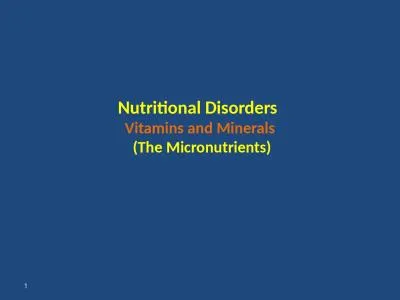

Vitamins and Minerals T he Micronutrients 1 Vitamins What are Vitamins B iochemical substances that are required in human diet for optimal physiological functions Why we need to study Vitamins ID: 913573
Download Presentation The PPT/PDF document "N utritional Disorders" is the property of its rightful owner. Permission is granted to download and print the materials on this web site for personal, non-commercial use only, and to display it on your personal computer provided you do not modify the materials and that you retain all copyright notices contained in the materials. By downloading content from our website, you accept the terms of this agreement.
Slide1
Nutritional DisordersVitamins and Minerals(The Micronutrients)
1
Slide2Vitamins What are Vitamins? - Biochemical substances that are required in human diet for optimal physiological functions.
Why we need to study Vitamins?
-Both deficiency and excess of vitamins can cause disease.
2
Slide3Vitamins Is Vitamins deficiency diseases presents in our country? - yes.They are most prevalent in developing countries but still present in developed countries.
3
Slide4Risk factors for vitamin deficiency Malnutrition.Older people. Growing children .Pregnancy.
Drugs.
M
aldigestion
M
alabsorption.
Alcoholics
4
Slide5Functions of Vitamins Vital roles in different physiological processes e.g. coenzymes.Some have pharmacological actions when given at supraphysiological doses e.g. Niacin and vitamin A.5
Slide6Classifications of Vitamins Fat soluble vitamins A, D, K, E (DEKA)Water soluble vitamins C, B- complex group
6
Slide7Fat soluble vitamins(DEKA)7
Slide8Vitamin A Sources :Animal source (Retinol): liver, fish, eggs. Plant sources (B-Carotene): dark greens and colored vegetables and fruits.Synthetic forms.Daily requirements: 1.5 mg= 5000 IU/day.
8
Slide99
Slide10Functions of vitamin ANight vision: retinaldehyde (retinal) is critical for rhodopsin in the rods of retina.Growth and cell differentiation: retinoic acid.Reproduction and embryogenesis.Humeral immunity.Hematopoiesis.Antioxidant: B-Carotene.
Therapeutic role: acne , psoriasis, leukemia.
10
Slide11Vitamin A deficiencyVitamin A is one of the most common causes of blindness in children around the world.Causes of vitamin A deficiency:Famine and under-nutrition.MalabsorptionObstructive jaundice.
Alcoholism.
Drugs e.g. cholestyramine.
11
Slide12Clinical features of vitamin A deficiencyVisual symptoms and signs:Night blindness: impaired vision in dim light.Xerophthalmia: dry lusterless cornea.
“Bitot’s spots”
: glistening white plaques of desquamated conjunctival epithelium firmly adherent to underlying conjunctiva.
Keratomalacia
: thinning and ulceration of the cornea, scaring and total blindness.
12
Slide13Xerophthalmia13
Slide14Bitot’s spots14
Slide15Keratomalacia 15
Slide16Other features of vitamin A deficiencyIncreased susceptibility to infections.Hyperkeratosis of the skin, acne, dry hairGrowth impairment in childrenFatigue , insomnia
Weight loss
16
Slide17Treatment of vitamin A deficiency Treatment of underlying cause if present.Encourage a vitamin A rich diet.Vitamin A (retinol) supplements (60 mg= 200,000 IU in form of retinyl palmitate repeated after 14 days then every six months.Eye surgeon referral if required.
17
Slide18Prevention of vitamin A deficiencyEncourage vitamin A rich diet.Prophylactic oral dose of retinol 60 mg (200,000 IU) for pre-school children.Fortification of food with vitamin A.
18
Slide19Vitamin A toxicity19
Slide20Vitamin A toxicityTwo forms :“Carotenemia” ; increased intake of B-Carotene“Hypervitaminosis A” ; increased intake of
retinol
20
Slide21Carotenemia High level of B-Carotene is not toxic, it cause (Carotenemia) which is a yellow-orange discoloration of skin especially palms and soles “but not sclera” and this resolve after decreasing B-Carotene intake.
This can also occur in cases of hypothyroidism (decreased metabolism of B- Carotene)
21
Slide22Retinol toxicity (hypervitaminosis A) - Two forms:Acute toxicityChronic toxicity (hypervitaminosis A)
22
Slide23Vitamin A toxicity (acute)Acute toxicity: ingestion of a single dose of 100- 150 mg of retinol will lead to abdominal pain , headache, vertigo, diplopia, bulging fontanels in children, seizures, and exfoliative dermatitis
.
23
Slide24Chronic vitamin A toxicity Chronic retinol toxicity occur if the daily intake is more than 15 mg=50,000 IU for more than three months.Symptoms include: dry fissured skin, hair loss, headache, nausea , vomiting ( Increase intra-cranial pressure) hepatomegaly and bone pain.
24
Slide25Vitamin A toxicitytreatmentConfirm diagnosis by measurement of level of vitamin ATreatment
is symptomatic and supportive.
25
Slide26Vitamin A and pregnancyIn high doses retinol is teratogenicPregnant women should not receive more than 3 mg/d of vitamin A (10,000 IU)
26